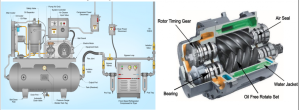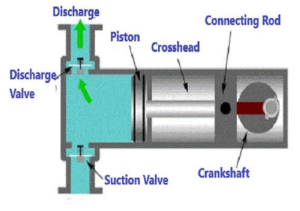Rotary screw compressors are the workhorses of many industries worldwide. They can run on a 100 % duty cycle – and they often work better and last longer when used in this way. Rotary screw compressors are also one of the most efficient type of compressors on the market, when sized correctly. There are many critical components involved in rotary screw air compressors, and the lubricant we use is of vital importance in protecting these components. These machines often work under severe conditions and rely heavily on the lubricant for bearing lubrication, system cleanliness, water removal, sealing, and heat transfer.
The two most common types of lubricant used in screw type compressors are polyalphaolefins (PAO) and polyalkylene glycols (PAG). These lubricants have very different characteristics. PAO lubricants are hydrophobic, while PAG lubricants are typically hydroscopic. Due to these characteristics, PAG lubricants have a high tolerance for water and can typically function normally with water content of up to 7000 ppm. However, this hydroscopic characteristic also makes it difficult for the lubricant to separate from water. This effectively reduces the lubricant’s ability to protect bearings. PAO lubricants, on the contrary, separate readily from water. This allows free water to be easily drained from the sump, maintaining a low water content. PAO lubricants are therefore considered the best choice for protection of rolling element bearings – of course this is assuming that proper maintenance practices are followed.
Generally, the most common causes of damage to components in rotary screw compressors are high water content, particulate contamination and lubricant oxidation. The primary source of both water and particulate contamination is the inlet air. Therefore, the inlet air filter should be cleaned regularly and replaced as required. Leaks between this filter and the air end is also a common source of contaminants.
Even with proper filtration of inlet air, some amount of water will be dissolved in the air. During the compression process, condensation of water occurs and this water mixes with the lubricant. Consequently, it is also important to periodically drain free water from the bottom of the sump in these types of compressors.
While synthetic lubricants have a long service life, they can deteriorate rapidly when the anti-oxidant package is depleted. Additive depletion can also be accelerated by water and wear particles. Frequent sampling of the lubricant is recommended to mitigate this problem.







